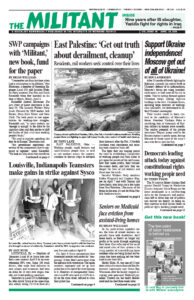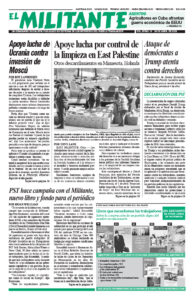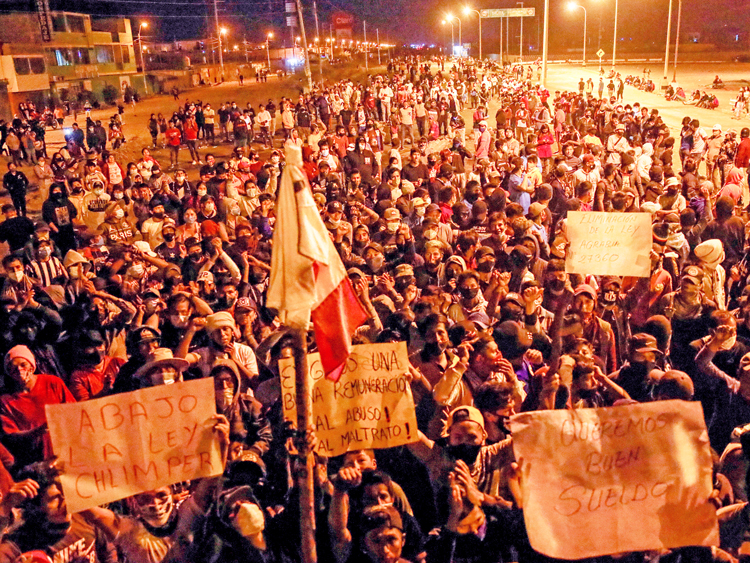While the protests that erupted across Peru after the Dec. 7 ouster of President Pedro Castillo have receded, the issues behind the social unrest and ongoing political crisis remain.
Castillo was deposed and jailed on charges of “breaching constitutional order” after he tried to dissolve Congress hours before he was to be impeached, saying he would rule by decree. His vice president, Dina Boluarte, was sworn in as the new president with the support of Congress, the courts and the army and police.
Street protests grew to include Indigenous organizations, trade unions, agricultural workers federations and peasant self-defense committees. Boluarte’s government responded with brutal repression that left 67 people killed, including 17 on one day in Puno province Jan. 9, which sparked more public anger.
“They removed him against the will of the people,” José Quispe, a Quechua-speaking potato farmer, told the Wall Street Journal March 23. “No one can humiliate us so easily.”
Thousands of Peruvians, many from the country’s poorest southern regions, descended on the nation’s capital, Lima, in January to demand Boluarte’s resignation, immediate elections and a new constitution. To defuse the protests, Boluarte announced elections would be held in 2023, but so far Congress has rejected all such proposals. Meanwhile, Castillo remains in prison and both he and Boluarte face new accusations of campaign finance violations and money laundering.
Peru’s current turmoil is part of a long string of political crises reaching back decades. Every president elected in the last four decades has been impeached, imprisoned or faced criminal charges. The sharp polarization in Peru is part of a trend in bourgeois politics in which rivals resort to impeachments, jailing opponents and dissolution of government branches to stay on top and serve local and international capitalist interests. “Anti-corruption” crusades have been used by capitalist political forces as a pretext to seek the exclusion of their opponents from the political arena, as happened in the case of Brazilian President Luis Ignacio Lula da Silva in 2018.
Underneath this political crisis in Peru is the capitalist rulers’ incapacity to reverse the deepening calamities the global crisis of capitalism imposes on working people there.
Castillo’s narrow electoral victory in 2021 was seen by millions from rural, working-class and Indigenous populations as the election of a “true man of the people” with high hopes that his presidency would confront the social crisis battering working people. He ran on a platform promising to raise taxes on the rich, increase mining royalties from foreign companies and rewrite the country’s constitution, which dates back to the Bonapartist regime of President Alberto Fujimori in the 1990s.
He campaigned on slogans like “No more poor people in a rich country,” but once in office kept reshuffling his cabinet to appease various blocs of bosses. None of the capitalist political figures in Peru have a program to relieve the crisis workers and peasants face.
Capitalist growth = exploitation
In the recent decades Peru has occupied business news headlines for its “uninterrupted” economic growth, fostering the myth that capitalist growth equals improved conditions for all. In fact, even before the country’s economy turned sharply down in 2020, conditions for the majority of working people have been devastating.
Peru is one of the world’s top producers of copper, zinc, silver and gold, and has significant oil and natural gas resources. It is also a major exporter of fruits and vegetables, textiles and fishmeal. The benefits that reach working people, however, are paltry, as Peruvian and foreign capitalists fatten their pockets.
In rural regions of the country 46% live in poverty. Some 16.6 million people — more than half the population — don’t have regular access to enough safe and nutritious food.
The number of Peru’s workers who are “informal” — self-employed and temporary and seasonal workers without benefits — is around 50% of the working population. Of the 234,000 workers in the mining sector, 72% are subcontractors who don’t have a union, receive less pay and benefits and often do the most dangerous jobs.
Workers’ resistance
“There is no stable employment,” a protester in an agricultural workers strike in the southern department of Ica told El Comercio in 2020. When we work, “we have a starting time, but never an ending time,” he added.
Working people in Peru, however, have not accepted these conditions and have fought against austerity and anti-working-class measures imposed by bosses and their governments. Fed up with conditions, protests erupted four months after Castillo took office, sparked by rising fuel prices and spiraling inflation. Prices had jumped by 8.46% a year, the highest in a quarter century. Vegetable oil and sugar went up by 35% to 50%.
A social disaster is currently unfolding as torrential rains have been hitting Peru since February. They have triggered deadly mudslides and floods in the northern regions that tore through shantytowns, destroying homes and livelihoods of thousands of people. These are not casualties of a “natural disaster,” but of an exploitative capitalist system that forces people to live in marginal areas.
This sharp class differentiation is also caused by Peru’s “economic miracle.”


